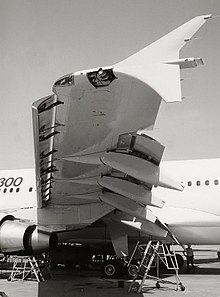Slat

Vane , also slats (pl.) Are small, at the front edge of the wing of an aircraft -mounted, aerodynamically efficient surfaces for influencing the flow during takeoff and landing. Extending the slats makes it possible to fly with a larger angle of attack . Since the lift is approximately proportional to the angle of attack and the square of the speed, this enables the aircraft to fly even more slowly than just with flaps, especially when landing or during other maneuvers close to the stall limit . This can be used, for example, to shorten the required take-off and landing distance on the runway . The slats are usually movable and are then retracted during flight to reduce air resistance .
There are several types of slats:
- Fixed slats are constantly extended or simply slits in the leading edge of the wing, they are almost only used on special aircraft that are designed for slow flight, as this significantly reduces the maximum speed of an aircraft (see e.g. the Fieseler Storch and the Polish Tow plane PZL-104 Wilga ).
- Automatic slats are flush with the leading edge of the wing and are extended forwards by springs as soon as the dynamic pressure decreases due to the lower airspeed. (see e.g. Morane-Saulnier Rally ).
- Driven slats can be extended and retracted electrically or hydraulically by the pilot . This type is common in modern commercial aircraft.
The slats usually only make up a few percent of the total wing depth. They increase the wing depth either over the entire wing width or only on the outer third of the wing.
By extending the slats, part of the air flow is accelerated through a narrowing slot and directed from the underside of the slat over the wing. The boundary layer on the main wing upper surface is blown therethrough and stabilized so that a stall at lower airspeeds and higher angles of attack is shifted. At the same time, a slat allows higher loads to be transported due to the higher lift generated during take-off and landing, also in connection with other high-lift aids.
The Krueger flap has in the extended state a similar aerodynamic effect as a slat. However, it differs in the mechanical design.
Some birds spread some feathers of the alula forwards when they land . This gives you an effect similar to that of a slat.
History of the slats
In 1918 Gustav Lachmann wanted to apply for a patent for the slat, but the German Patent Office refused. He developed the first fixed slat for Handley Page in England. This design was used especially for aircraft that had to make do with a short runway, for example on the German Fieseler Fi 156 , also known as Storch (bottom right picture). The stork had a runway length of 45 m for take-off and only 18 m for landing.
The first automatic slats were developed before the Second World War . So used z. B. Willy Messerschmitt automatic slats on the Bf 108 and Bf 109 to reduce the air friction of the wings and thus to achieve higher top speeds. Nevertheless, enough lift must be available during take-off and landing, which the slats provide.
In the post-war period, the slats were greatly developed. As early as the Swiss self-construction project N-11 of 1946, the slats should not only have been extended for slow flight, but should also have served as maneuvering aids in aerial combat in intermediate positions . The following Project P-16 flew with nose flaps from 1955. In the future, slats were driven hydraulically or electrically, thus allowing more variable use.
Individual evidence
- ^ Georges Bridel: Swiss jet aircraft and jet engines. , Schweizerische Bauzeitung, year 94, 1976, issue 20, page 266ff


